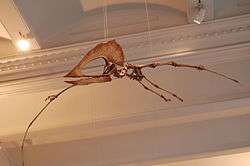Tupuxuara
| Tupuxuara Temporal range: Early Cretaceous, 112–108 Ma | |
|---|---|
 | |
| Replica skeleton of T. leonardii | |
| Scientific classification | |
| Kingdom: | Animalia |
| Phylum: | Chordata |
| Order: | †Pterosauria |
| Suborder: | †Pterodactyloidea |
| Clade: | †Azhdarchoidea |
| Clade: | †Neoazhdarchia |
| Family: | †Thalassodromidae |
| Genus: | †Tupuxuara Kellner & Campos, 1988 |
| Type species | |
| †Tupuxuara longicristatus Kellner & Campos, 1988 | |
| Species | |
|
†T. longicristatus Kellner & Campos, 1988 | |
Tupuxuara is a genus of large, crested, toothless pterodactyloid pterosaur.
Discovery
The genus was named and described by Alexander Kellner and Diógenes de Almeida Campos in 1988.[1] The type species is Tupuxuara longicristatus. The genus name refers to a familiar spirit from the mythology of the Tupi. The specific name means "long-crested" in Latin.
The holotype, MN 6591-V, was found in the Cretaceous Santana Formation of Brazil. It consists of a snout and some partial wing bones. Mature individuals of T. longicristatus had a back-swept crest arising from the snout. Much more fossil material has later been found, showing considerable variation in morphology. Some researchers explain this as intra-specific variability, being caused by a difference in age or sex. Others, however, assume there are different species present.
In 1994 a second species was named by Kellner: Tupuxuara leonardii. The specific name honours Giuseppe Leonardi.[2] The holotype is MN 6592-V, a fragmentary skull with a more rounded crest. Other such material has been referred to T. leonardii. The largest skulls have a length of 130 centimetres indicating a wingspan of 5.5 metres (18 ft).
In 2009 a third species was named, by Mark Paul Witton: Tupuxuara deliradamus. The holotype is SMNK PAL 6410, a skull. Another skull is the paratype: KPMNH DL 84. The specific name is derived from Latin delirus, "insane" or "crazy", and adamas, "invincible" but also the word from which "diamond" is derived. The species has a distinctive diamond-shaped skull opening and low eye sockets. The name is a tribute to the song "Shine On You Crazy Diamond" by Pink Floyd, one of Witton's favourite bands.[3]
Classification
Tupuxuara is a member of the group Azhdarchoidea. Kellner assigned it to the Tapejaridae within Azhdarchoidea. According to some analyses however, Tupuxuara is closer to the Azhdarchidae (the group that includes the giant Texan form Quetzalcoatlus) than to Tapejara and its relatives.

The cladogram below follows the 2011 analysis of Felipe Pinheiro and colleagues.[4]
| Azhdarchoidea |
| |||||||||||||||||||||||||||||||||||||||||||||||||||||||||||||||||||||||||||
| |
Palaeobiology
It has been suggested that Tupuxuara was a fish eater at the coasts of South America. Other hypotheses include the possibility it was a fruit eater.
A subadult described by David Martill and Darren Naish from the University of Portsmouth in 2006 had not yet fully developed its crest, which supports the suggestion that the crest was a marker for sexual maturity.
Comparisons between the scleral rings of Tupuxuara and modern birds and reptiles suggest that it may have been diurnal.[5]
References
- ↑ Kellner, A.W.A., and Campos, D.A. (1988). "Sobre un novo pterossauro com crista sagital da Bacia do Araripe, Cretaceo Inferior do Nordeste do Brasil. (Pterosauria, Tupuxuara, Cretaceo, Brasil)." Anais de Academia Brasileira de Ciências, 60: 459–469. [in Portuguese]
- ↑ Kellner, A. W. A.; Campos, D. A. (1994). "A new species of Tupuxuara (Pterosauria, Tapejaridae) from the Early Cretaceous of Brazil". An. Acad. brasil. Ciênc. 66: 467–473.
- ↑ Witton, M.P. (2009). "A new species of Tupuxuara (Thalassodromidae, Azhdarchoidea) from the Lower Cretaceous Santana Formation of Brazil, with a note on the nomenclature of Thalassodromidae", Cretaceous Research 30'(5): 1293-1300
- ↑ Pinheiro, F.L., Fortier, D.C., Schultz, C.L., De Andrade, J.A.F.G. and Bantim, R.A.M. (in press). "New information on Tupandactylus imperator, with comments on the relationships of Tapejaridae (Pterosauria)." Acta Palaeontologica Polonica, in press, available online 03 Jan 2011. doi:10.4202/app.2010.0057
- ↑ Schmitz, L.; Motani, R. (2011). "Nocturnality in Dinosaurs Inferred from Scleral Ring and Orbit Morphology". Science 332 (6030): 705–8. doi:10.1126/science.1200043. PMID 21493820.